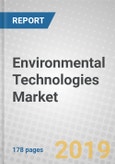Report Scope:
The main challenges in the study of the competition in environmental technologies and services contribute to industry description, range and limitations. This is partly due to the complexity of the definition and the lack of information in some areas that are more recent and rapidly growing. There are many reports that have attempted to identify, assess and explain the global, regional and local markets, but they offer little consensus. Each sector has a diverse range of goods and services. Each market has a variety of products and services that are used to clean up existing production systems, treat water and sewage, control environmental pollution and reduce noise.
Several waste management and recycling technologies and services address past environmental damage. A growing range of environmental services, including research, design and engineering services, also are available. Most of these manufacturing and engineering operations are heterogeneous, which hinders data collection and comparisons. There also is a lack of consensus on standards for identifying sector limits.
Most emission prevention and management systems and facilities suppliers have a low level of efficiency in filtering pollutants Other goods and services that are a key business line and therefore are not readily separable for inclusion in the Environment Industry measures, may be classified by environmental technologies and services. Ultimately, various studies on behaviors or goods yield divergent findings, whether for ecological workplace surveys, eco-product surveys, and general quantitative surveys. Values shift because they rely on supply or demand calculations on which they are based.
Despite definition and measurement problems, these technologies should be considered an industry aspect. Cleaner technologies are difficult to measure because their improvements cannot be discerned from more efficient improvements that use fewer resources, produce less waste and harmful by-products. The industry can be defined by including goods and services in areas such as water, air, noise, soil, solid waste, natural resources and various services.
The publisher examined key categories and regions of the environmental technologies and services market and forecasted market growth from 2019 to 2024.
The Report Includes:
The main challenges in the study of the competition in environmental technologies and services contribute to industry description, range and limitations. This is partly due to the complexity of the definition and the lack of information in some areas that are more recent and rapidly growing. There are many reports that have attempted to identify, assess and explain the global, regional and local markets, but they offer little consensus. Each sector has a diverse range of goods and services. Each market has a variety of products and services that are used to clean up existing production systems, treat water and sewage, control environmental pollution and reduce noise.
Several waste management and recycling technologies and services address past environmental damage. A growing range of environmental services, including research, design and engineering services, also are available. Most of these manufacturing and engineering operations are heterogeneous, which hinders data collection and comparisons. There also is a lack of consensus on standards for identifying sector limits.
Most emission prevention and management systems and facilities suppliers have a low level of efficiency in filtering pollutants Other goods and services that are a key business line and therefore are not readily separable for inclusion in the Environment Industry measures, may be classified by environmental technologies and services. Ultimately, various studies on behaviors or goods yield divergent findings, whether for ecological workplace surveys, eco-product surveys, and general quantitative surveys. Values shift because they rely on supply or demand calculations on which they are based.
Despite definition and measurement problems, these technologies should be considered an industry aspect. Cleaner technologies are difficult to measure because their improvements cannot be discerned from more efficient improvements that use fewer resources, produce less waste and harmful by-products. The industry can be defined by including goods and services in areas such as water, air, noise, soil, solid waste, natural resources and various services.
The publisher examined key categories and regions of the environmental technologies and services market and forecasted market growth from 2019 to 2024.
The Report Includes:
- 38 data tables and 28 additional tables
- An overview of the global markets for environmental technologies
- Analyses of global market trends with data from 2018 to 2019, and projections of compound annual growth rates (CAGRs) through 2024
- Identification of the technical as well as other non-technical challenges that must be prevailed over for the market to realize its full potential
- A look at the regulatory affairs and the level of government expenditures (in developed as well as developing economies) committed to the environment that will shape the future marketplace
- Insight into the patent summary and analysis along with new developments within the technology segment
- Competitive landscape covering major stakeholders and profile description of key market players, including Teledyne Technologies Inc., General Electric Co., Siemens AG, Thermo Fisher Scientific Inc., Environmental Remediation Resources Pty Ltd. and Bactech Environmental Corp.
Table of Contents
Chapter 1 Introduction
Chapter 2 Summary and Highlights
Chapter 3 Global Market for Environmental Equipment
Chapter 4 Global Market for Environmental Services
Chapter 5 Market Breakdown by Region
Chapter 6 Company Profiles
List of Tables
List of Figures
Companies Mentioned
- Abatement Technologies Inc.
- Aecom
- Arcadis Nv
- Bactech Environmental Corp.
- Cypher Environmental Ltd.
- Energy Capital Partners
- Environmental Remediation Resources Pty Ltd.
- Evergreen Pacific Partners
- Freudenberg Filtration Technologies
- General Electric Co.
- Geo-Cleanse International Inc.
- Geovation Engineering
- Ground/Water Treatment & Technology Llc
- Hydrus Technology
- Ivey International Inc.
- Lennox International
- Siemens Ag
- SRL Plasma Pty Ltd.
- Stantec, Inc.
- Teledyne Technologies Inc.
- Tetra Tech, Inc.
- Thermo Fisher Scientific Inc.
- Trc Companies Inc.
- Worleyparsons Ltd.








